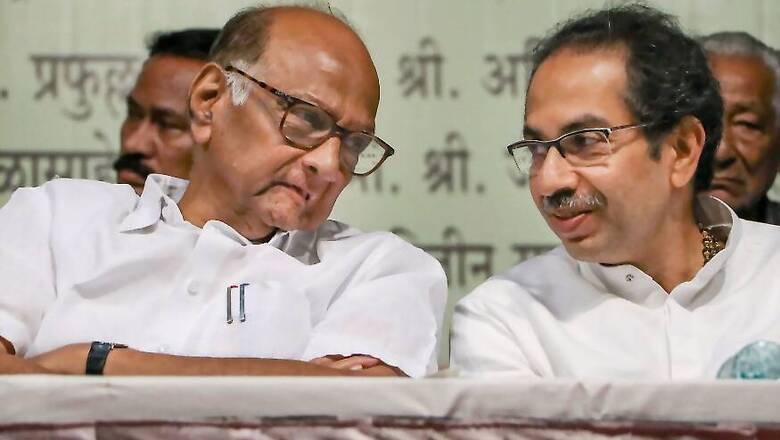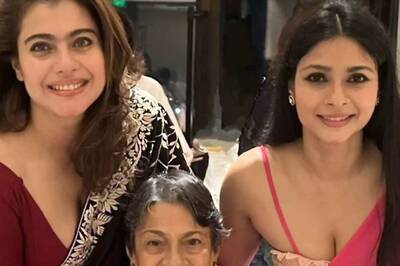
views
The freedom of the press, as the popular saying goes, belongs only to those who own it.
But when the Shiv Sena mouthpiece Saamana, which is controlled by the Thackeray family, broke with convention to run a marathon interview with Nationalist Congress Party (NCP) chief Sharad Pawar, some eyebrows were raised.
Saamana carries such three-day long, full-page interviews with members of the Shiv Sena’s first family, that is, supremo late Bal Thackeray and Maharashtra chief minister and Sena president Uddhav Thackeray.
Late last week, Saamana broke with this tradition to carry a similar interview with Pawar. The interview was conducted by Shiv Sena Rajya Sabha MP and Saamana executive editor Sanjay Raut. The newspaper has Uddhav’s wife Rashmi as the editor. Her husband had stepped down from the position after becoming the chief minister.
The purpose of the interview, as was obvious, was to show that all is well within the ruling multi-party alliance and paper over differences on issues like the transfers of senior police officials and the NCP’s short-lived moves to poach corporators from the Sena.
For leaders and cadre of both parties and neutral political observers, this signifies that the leaderships of the two parties are moving closer politically. And, therein lies the rub…
The Uddhav Thackeray-led ‘Maha Vikas Aghadi (MVA)’ which comprises the Shiv Sena, NCP, Congress, and smaller players, was born out of a sense of political expediency, and the need to keep the Bharatiya Janata Party (BJP) away from power. As some Shiv Sena leaders admit, they had to snap their alliance with the BJP and keep it away from the treasury benches out of a growing sense of existential crisis.
However, for Shiv Sena leaders and their grassroots cadre in the hinterlands, the proximity to the NCP has been difficult to digest.
Like the Shiv Sena, the NCP, despite its national level player pretensions, is a regional force, and has almost everything at stake in Maharashtra. The Shiv Sena and NCP share an overlapping and often clashing sub-regional and social base in the state.
For instance, there are several districts, where the Congress and BJP are bit players, with the Sena and BJP being the prime contenders for political supremacy. While the NCP has a base in the dominant Maratha community, the Shiv Sena is seen as a party of the other backward classes (OBC). OBCs, who form around 53% of the population across religious denominations, are becoming increasingly assertive and upwardly mobile due to quotas in education, jobs and local self-government politics and often take on the Marathas, who are firmly entrenched in traditional power structures.
The Shiv Sena has a wide social base, next perhaps only to the Congress, and the other backwards, who form the backbone of its support, often clash with the Marathas for political supremacy.
The Shiv Sena and NCP contest a bulk of seats against each other. Hence, it is obvious that one party can grow at the cost of the other, as was evidenced by the NCP’s short-lived move to poach Shiv Sena corporators from Parner, which led to a furore.
During his lifetime, Shiv Sena supremo Bal Thackeray was a political rival of Pawar, despite the personal warmth that they shared.
Shiv Sena leaders complain that in areas where the two parties are ranged against each other, their counterparts from the NCP often play the politics of one-upmanship with the active connivance of the NCP leadership and ministers.
Unlike those from the Shiv Sena, ministers from the NCP and the Congress have better administrative experience. The NCP, which holds crucial portfolios like finance, home, co-operation, and housing is seen as being in charge of the government unlike the Sena, which as its cadre admit, gives the perception of being in power but not in authority.
The NCP’s Ajit Pawar, who as the deputy chief minister in the MVA government, lives up to his Dada (elder brother) nickname, is seen as the alpha male of the regime, running roughshod over others at times. Ajit is more hands-on compared to Uddhav, who even as his ministers and legislators admit, is difficult to access.
Shiv Sena leaders fear that put together, these factors will ensure that the NCP will use its position to gradually chip away at their base, brick-by-brick, much like the BJP did during its time in power from 2014 to 2019. This fear has a precedent as in the past, the Shiv Sena has lost more leaders to the NCP than to other parties.
There is another sword hanging over the MVA — that of political instability. The BJP, which is wary of the MVA setting a template for disparate parties in other states to follow, claims it can dislodge the dispensation from power due to the contradictions inherent in this alliance.
Though Pawar is playing the role of an elder statesman in the MVA, his record as an unreliable ally adds to this niggling fear. For instance, Pawar has changed his political position once or twice in almost every decade in his over 50 years of public life. His alliance with the Shiv Sena as part of the MVA comes after an unsuccessful attempt at forging a pre-poll tie up with it for the 2009 Lok Sabha elections, when the NCP and Sena were in an alliance with the Congress and Sena respectively.
From the Sena, Raut, whose proximity to Pawar is an open secret, was among those who was said to be rooting for this alliance, which eventually fell through.
Shiv Sena leaders admit that much of what happened the behind-the-scenes before the BJP’s Devendra Fadnavis took oath as the chief minister of Maharashtra for a second, five-day term with Ajit, who is Pawar Sr’s nephew, is yet to be revealed.
In the interview to Raut, Pawar also spoke about how the MVA constituents could contest the next elections together if they planned their strategy well. Though this could be difficult to implement at the brass tacks, the statement may be aimed at keeping any likely defections in check.
As the NCP and Shiv Sena inch closer, they may have to contend with rising unease in the third pole of the alliance — the Congress.
Maharashtra Youth Congress president Satyajeet Tambe in an angry tweet questioned why advertisements for the state government’s Mahajobs portal, featured photographs of just Uddhav, Ajit, and industries minister Subhash Desai, who belongs to the Shiv Sena, while leaving out ministers from the Congress.
Tambe, the nephew of Congress state unit chief and revenue minister Balasaheb Thorat, asked if the scheme was promoted by the alliance government or the Shiv Sena-NCP. He asked why the common minimum programme and the necessary protocols decided upon while forming the MVA were not being followed.
Though Congress leaders admit that for the party, the urge to be part of the government was more important than the optics of breaking bread with former adversary, the Shiv Sena, there is growing unease at the Sena and NCP dominating the government.
There is fear that the NCP-Shiv Sena bonhomie may lead to them ditching the Congress in the future. The onus of proving wrong the “two is company, three is a crowd” adage lies on the Shiv Sena and NCP leadership, they note.



















Comments
0 comment